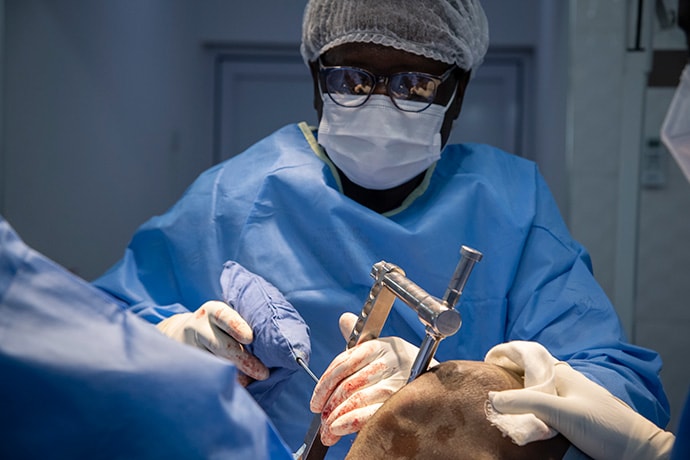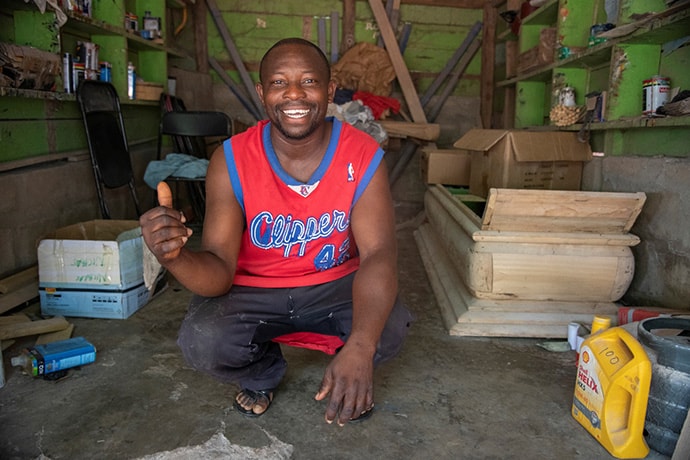By Ryan Smith, SIGN Fracture Care

SIGN Surgeon Dr. Sibiri Ballu. Photo: Chuck Bigger for SIGN Fracture Care
Traumatic injuries, including fractures, are a major cause of disability and death worldwide. The World Health Organization estimates that 20-50 million people are injured every year in traffic accidents, in addition to injuries caused by falls, workplace accidents, and violent conflict. In high-income countries, people with trauma injuries are treated in a fully equipped hospital, often on the same day the injury occurs. But in low- and middle-income countries (LMIC), access to fully staffed and equipped hospitals is much more difficult. Nearly 1 billion people in the world do not have access to a hospital with a reliable supply of electricity, let alone a fully equipped surgical suite.
Without proper treatment, injuries like long bone fractures (femur, tibia, and humerus) can easily turn into lifelong disabilities. When bone fragments grow together out of proper alignment, the injured person is left with a shortened or bent limb that is painful to use, often causing long-term mobility issues, a reduced quality of life, and preventing the person from returning to work. In addition, when a person is disabled by injury, a family member needs to provide basic care and support, which is a further economic setback as that support person is partially or fully removed from the workforce.
Treatments like traction and plaster casts can be effective in some injuries, but severely fractured long bones can cause the patient to be immobilized for up to three months and have a low rate of successful healing. In high-income countries, the gold standard of treatment for a fractured long bone is an intramedullary nail, which is surgically inserted into the fractured bone canal and secured with screws at each end. This provides stability so that the bone fragments can heal together in the proper alignment and provides support so that the injured person can bear weight and walk while the bone heals. Commercially available implants rely on C-arms (live-view x-ray machines) in the operating room to be used. Most hospitals in LMICs do not have access to C-arms or cannot afford them.
SIGN Fracture Care developed a system of orthopaedic instruments and intramedullary implants specifically for use in austere operating environments. These include a targeting arm that guides the surgeon to insert the nail and find screw locations using tactile feedback, rather than a C-arm machine. This enables orthopaedic surgery to be performed in hospitals and local clinics —even in tents after natural disasters. With SIGN Surgery, a patient with a broken leg can stand and walk with support the day after surgery, leave the hospital within a week, and often return to work or school within one month.

Photo of Nicholas’ accident. Photo: Chuck Bigger for SIGN Fracture Care
A recent patient who received SIGN Surgery is Nicholas, who was injured in a traffic accident in Ghana. He is a husband and father of four, and he operates three businesses to support his family. Nicholas’ world came to a screeching halt when the truck he was traveling in blew a tire and rolled over, throwing Nicholas and other passengers from the vehicle. He was transported to an area hospital with injuries to both shoulders, a pelvic fracture, and a badly broken left femur.

Happy and healed Nicholas. Photo: Chuck Bigger for SIGN Fracture Care
Nicholas spent two weeks in the hospital with no real progress toward recovery because the facility was not equipped for orthopaedic surgery. He was transferred two hours away to Wenchi Methodist Hospital, under the care of SIGN Surgeon Dr. Sibiri Ballu. In one surgical session, Dr. Ballu repaired both of his shoulder injuries, his pelvic injury, and implanted a SIGN Nail in Nicholas’ broken femur.
Nicholas was discharged from the hospital only four days after this successful surgery. Two weeks later, he was back at work helping his wife operate their small convenience store, along with the small poultry farm near their home. He was also able to resume his daily three-mile walk to town, where he builds coffins in his carpentry shop.
“I am as strong as I was before the accident,” says Nicholas. “I have seen my friends who didn’t go to the hospital after the accident, they can’t even work and even walking is hard for them, but for me I am working as before the accident.”
By providing timely and effective fracture treatment for people like Nicholas, SIGN helps to reduce the risk of disability and improve patients’ overall health outcomes. Furthermore, the organization’s focus on training local healthcare providers ensures that these benefits are sustainable, with local providers able to continue providing quality care for decades to come.
SIGN Instruments and Implants are designed and manufactured in Richland, Washington. Through donor support, SIGN provides orthopaedic instruments and implants at no cost to hospitals or patients. This removes a significant financial barrier to treatment. Commercially available implants cost around $2,000 USD — nearly the annual income for someone living below the poverty line.
Since 1999, SIGN has supported more than 7,000 surgeons and helped more than 400,000 people recover from bone fractures.
* * * * * * * * * *
SIGN is a humanitarian organization that builds sustainable orthopaedic capacity in developing countries by providing relevant education to surgeons, then manufacturing and donating the instruments and implants needed to treat fractures. signfractureinternational.org